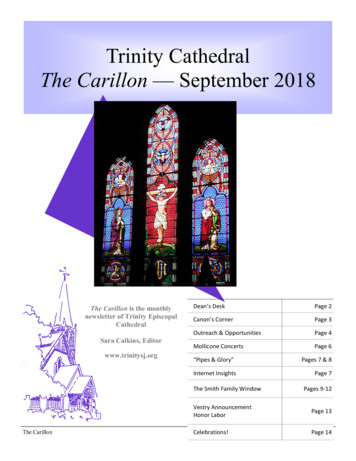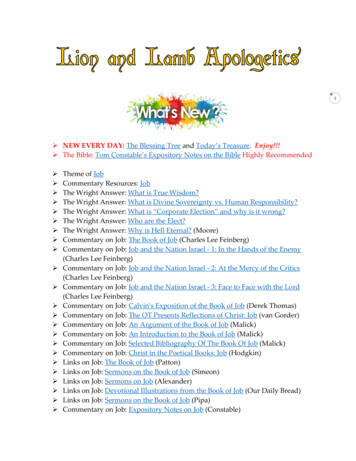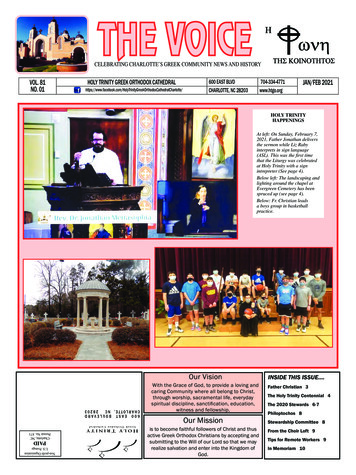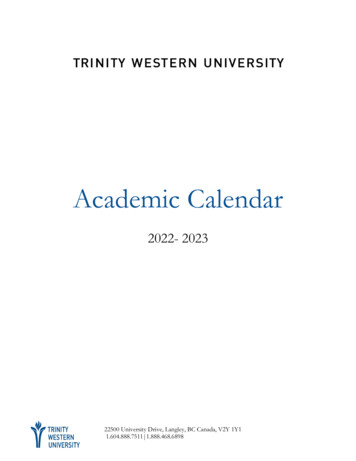
Transcription
Trinity CathedralThe Carillon — September 2018The Carillon is the monthlynewsletter of Trinity EpiscopalCathedralSara Calkins, Editorwww.trinitysj.orgDean’s DeskPage 2Canon’s CornerPage 3Outreach & OpportunitiesPage 4Mollicone ConcertsPage 6“Pipes & Glory”Internet InsightsThe Smith Family WindowThe CarillonPages 7 & 8Page 7Pages 9-12Vestry AnnouncementHonor LaborPage 13Celebrations!Page 114Page
The CarillonSeptember 2018TrinityEpiscopal Cathedral“A place at God’s table for everyone”Diocese of El Camino ReálThe Right Reverend Mary Gray-Reeves, BishopTrinity Cathedral StaffThe Very Rev. David Bird, Ph.D.Dean and RectorMr. Michael JoyceMusic DirectorMs. Heike HastingsCathedral AdministratorMr. John DavisSextonVolunteer StaffThe Rev. Canon Randolf J. Rice, J.D.Canon ResidentiaryThe Rev. Canon Lance Beizer, J.D.Canon VicarThe Rev. Lee Barford, Ph.D.DeaconJames HaddadTreasurerGraciela VelazquezCoordinator for Latino MinistriesThe Rev. Penelope Duckworth, M.F.A.Mr. Stuart JohnsonArtists in ResidenceProfessor Brent WaltersScholar in ResidenceJ. F. Alexander, M.A., J.DWriter in ResidenceFrom the DeanWe tend to associate late August/September with schools starting backand with everything getting back into gear after vacations. In the Diocese of El Camino (ECR) we are seriously starting a search for a successor to Bishop Mary Gray-Reeves.The parish membership have received a survey to fill out so that eachone of us can give input to the search committee as to our hopes andexpectations for the future. If you have not yet completed a survey orform I ask that you please do so. Even more importantly, keep prayingfor the work of the search committee and the future of the diocese.It’s very important that each and every one of us pray carefully aboutour diocesan future and the future of The Episcopal Church. There aremore than twenty elections of a new bishop nationwide to take placebefore we cast our ballots and clearly this is a major time of transitionfor a large proportion of the national church.Think hard about what you consider the primary qualities are we needin our next bishop; pray for the search committee; and discuss yourhope for the future with other members of the parish and diocese.What qualities do you hope the search committee will be looking for in(Continued on page 5)Trinity CathedralEstablished 186181 N 2nd Street, San Jose CA 95113-120524-hour phone 408 293-7953 Fax 408 293-4993 E-mail: trinicat@pacbell.net Web site: www.trinitysj.orgThe CarillonSubmissions to The Carillon may be sent via e-mail to the office or to editor, Sara Calkins, at calkins3@ix.netcom.com.Please indicate “For the Carillon” in the subject line.Page 2
Canon’s CornerTen years ago this month Annand I moved from Campbell tothe town I had grown up in: Canaan, Connecticut, a communityof, depending on whether youcount the entire town or just thevillage proper, somewhere between 1,500 and 2,500 people. Iarrived precisely on my seventieth birthday. That afternoon, because Connecticut property transfers are handled not by title companies, but by attorneys, I was sitting in our lawyer’soffice completing the paperwork to purchase our newhome when my cell phone rang. It was a call from a SanJose friend who wanted to wish me “happy birthday,”and who didn’t know that we had left California. It put asmile on my face, but at the same time a bit of a tug inmy heart. I had, after all, lived nearly fifty years in California.I wrote about our move in my very first Canon’s Cornercolumn, published that same month, in which I took upthe question—borrowed from Thomas Wolfe—ofwhether it really is possible to go home again. I concluded that because I was returning after so many yearsaway that, no matter whether nothing at all hadchanged in the town, so much had changed in me because of my own life experience, it could no longer bethe same place for me that it had been in my youth; itsimply can’t be home in the same way it once was. Mostof the houses here are old Victorians, but we were ableto find a promised adult development that met our desire to have an open-concept, single-story house with air-conditioning and a walkout full basement. The homewas essentially built to our specifications. The price wasless than a similar house would have cost in California,but considerably more than the houses on streetsaround us. Since we bought it in 2008, just as terribletimes hit the housing market, ours remain the onlyhouse to have been built in the development except themodels. The developers decided that they needed toremove a restriction against children. During a zoninghearing, someone referred to us as the rich outsiders—obviously not realizing that I grew up here.Now that I’m turning eighty, however, it’s time to reflecton what the journey has been like to have this littleThe Carillontown be for me the metaphorical bookends for my life.When I wrote about Canaan in 2008, I noted that it wasa bustling town with many stores and restaurants withinwalking distance of our home. Alas, I’m afraid I wasmore remembering what it was like in the ‘50s, before Ihad moved to California, than as it turned out to bewhen I moved back. I wrote the column before I hadwalked through the downtown area. By the time of myreturn there was no bookstore, no clothing stores, orplace to get an espresso. There was a functioning movietheater, which even had two floors, on one of which youcould order a meal to go with the movie. Sadly, though,that was gone within two years. A mark of distinction forCanaan is its train depot—the first in the country thatserved both an east-west and a north-south route. Thenorth-south route still functioned regularly with passenger service when I was a kid, but that ended in the early‘70s. There is now only a freight line that runs for just afew miles north into Massachusetts and through Canaansouthward about halfway down the state and back. Thedepot has always been a focus of interest in the community, but in October 2001 it was burned down by a couple of careless teenagers. It has taken until just aboutnow for it to reopen with a railroad museum, a couple ofshops and offices, and a restaurant and microbrewery.Perhaps that will bring some tourists back. I don’t holdout a whole lot of hope, though, that Canaan will everbe the town it was in my childhood.As a child I attended Sunday School at the tiny, butlovely, Neo-Gothic Episcopal church in the center oftown, designed by the same person responsible for Trinity Church, Wall Street, in New York City. On several occasions since my return I presided at Eucharists in thechurch, substituting for the regular priest when she wasunavailable. As you can imagine, those were very specialexperiences, but, again, there’s great sadness for mebecause several years ago the congregation, which hadshrunk dramatically from its size in my youth, ceased tobe able any longer to sustain itself and therefore had toclose. The building was deconsecrated and has been forsale ever since.On the upside, the town has acquired in the years since Ileft it a large Becton Dickinson plant that produces disposable medical syringes, a growing in-patient drug andalcohol rehabilitation facility, and an excellent retire(Continued on page 4)Page 3
Opportunities & OutreachAnnual Labor Day Bell ConcertMonday, September 3, 2018 — 3pmBring a chair, a snack and gather in the patio between the church and office buildings.Lunch for People Who are HomelessNext lunches will be held on September 8 and 15, 2018.For the lunch on August 11, a group of 12 enthusiasticvolunteers gathered to make and serve lunch to residents at Cecil White Center and nearby Julian St. Inn. Weserved a resident favorite; pasta with meat sauce, garlicbread, and green salad, along with milk and juice, icecream sundaes, and an assortment of cookies, pies andfruit.Many thanks go to Leslie Barr for her meal idea and toparishioners, Doreen and Marc Volcere, who did theshopping. (Thanks in advance to Mary Ellen Hawkins,who will do the shopping for our second lunch in Au-gust.) Friend of the parish and long-time volunteer, BarbPurdy, stepped in as chef today, creating a deliciousmeat sauce, cooked the pasta to perfection, and alsoconcocted the delicious garlic butter spread for our garlic bread.A big thank you goes to five more friends of the parish,Julia Dunker who will be starting UC Berkeley in the fall,her dad, Mike, her grandparents and first-time volunteers, Myrl and Chuck, and to SJSU student, TommyHuynh, a member of SJSU’s Circle K service organization.The steady help of the friends of the parish over thesesummer months is very much appreciated as we wouldbe short-handed without them.(Continued on page 5)Canon’s Corner, continued(Continued from page 3)ment community complete with assisted living and nursing components—to which is attached a physical therapyprogram open to the public, a small family YMCA, andshuttle bus service that is made available not only to residents of the retirement community but also to anyone inCanaan, free of charge.So what is it like for me after ten years back in the townwhere I grew up? Do I miss life in California? Am I happyto be back in a town that has changed so much in theyears I’ve been gone? Well, of course I miss the folks inCalifornia that I have loved over the years I lived there. Imiss the fact that so many things I loved about the SouthBay are more difficult to access here: espresso, frozen yoThe Carillongurt, and books are at the top of my personal list. I couldeasily do without mosquitoes, poison ivy, and the potential for getting Lyme disease and West Nile virus. On theother hand, the Berkshires are lush in the Summer andglorious in the Autumn. And every time I drive the sevenmiles to my church in Salisbury, I drive over the Appalachian Trail. How cool is that? So, whether East or West,may God bless us all!—LancePage 4
From the Dean, continued(Continued from page 2)presenting a list of candidates they will be recommending to the electing convention? Think and prayabout all of this and contribute to the future of the diocese in whatever way you can.- In Christ, David BirdDiocese on-line surveysIn English:https://www.surveymonkey.com/r/KYF26GMIn Spanish:https://es.surveymonkey.com/r/TXDRD2TPrint surveys are also available in church and/or the church office. Please return surveys to your rectoror church office.Opportunities & Outreach, continued(Continued from page 4)Thanks also go to parishioners Karen Gillette who assistedwith the cooking duties, Cheryl Griffin, Joan Rayment, RajAntony, and especially to new volunteer, Alicia Kenny,who has been attending Trinity Cathedral for severalmonths. Everyone pitched in, prepping all the ground turkey, celery, and onions for the sauce, producing a halfdozen loaves of steamy hot, and delicious, garlic bread,and later helping to wash, chop, and grate the veggies forthe salad. An extra thank you goes to Joan, Julia, Mike,and Cheryl for washing the veggies for the salad and alsothe many cutting boards, knives, and pots and pans.A big thanks goes to Rick Hawes, for donating the veggiesfor the salad, a large bottle of juice, a bag of fruit, acheese cake, and fruit pies. He not only brought all theveggies for the salad, he also coordinated everyone withmaking the salad and while at Cecil White Center set outthe fruit and cut up a juicy watermelon.After setting up for lunch at the Center, everyone donnedgloves, hats, and aprons with Mike dishing out the pastawhile Barb served salad, and Myrl and Chuck topped offthe plates with slices of garlic bread and parmesancheese. Julia worked at the dessert counter, handing outThe Carillonslices of yummy pies, cheese cake, peach cobbler, and icecream sundaes. Raj worked at the beverage counter fillingglasses with icy cold milk and juice.Thanks to Lucky supermarket, at the corner of Saratogaand Pruneridge Avenues in Santa Clara, and especiallymanagers, Andrew and Reuben, and bakers, Ernie, Amina,and Sandy for their continuing support. They contributebaked goodies whenever possible to our lunches for whichwe are extremely grateful. Another thank you goes to Rajfor arranging for the baked goods this week.Next month’s lunches will be held on two Saturdays, September 8 and 15, 2018. About 10 volunteers are neededfor this local mission activity so if your schedule allowsplease consider coming and helping. We meet to preparelunch at 10:00 am in the kitchen of the Parish Hall. No experience is required, just a desire to help those less fortunate than ourselves. There is a sign-up sheet on the bulletin board in the Parish Hall. If you have any questions,please ask any of the volunteers or Fr. Bird.- Alan FongPage 5
The Beatitude Mass Choir PresentsWHAT:Two Performances of Henry Mollicone’s Beatitude Mass (Mass for the Homeless)WHEN:September 15, 2018, 7:30 pmSeptember 23, 2018, 7:30 pmWHERE:Prince of Peace Lutheran Church, Saratoga (September 15, 2018)Cathedral Basilica of San Jose, Downtown San Jose (September 23, 2018)WHY:As part of his continuing commitment to social justice and the plight of the homeless, local composerHenry Mollicone will conduct two performances of his Beatitude Mass.Both concerts are free: donations will be gratefully accepted, and all proceeds will be directed to localorganizations that provide support and services to the homeless in our communities.The idea for composing the Beatitude Mass evolved from discussion between Mr. Mollicone and his good friend FatherJohn Pedigo. The piece incorporates words from the Latin Mass Ordinary, juxtaposed with English words by WilliamLuce. The new texts are drawn from interviews Mr. Mollicone and Father Pedigo conducted with people living in localhomeless shelters. It is Mr. Mollicone’s intent that performances of the Beatitude Mass raise funds to support servicesand programs for the homeless in the communities where it is performed. Since its premiere, he has donated all composer’s royalties to support such services. The two concerts will feature the Beatitude Mass as well as shorter works byMr. Mollicone, Handel, and Chopin.About the Beatitude Mass Choir: The Beatitude Mass Choir, recentlyformed by Mr. Mollicone, and the soloists and instrumentalists, arelocal musicians who volunteer their time. The purpose of the BMC isto give free community concerts, accepting donations for charitiesthat support social justice work for causes such as homelessness,immigration, and the plight of refugees.The CarillonPage 6
Music at Trinity — “Pipes & Glory”Nothing can compare to the experience of music. While God’s word renews the mind, music provides us with an experience that moves the spirit and restores the soul.We have a vision for music at Trinity. Music has played an enormous role in the life of Trinity Cathedral as well asdowntown San Jose. In the past, many a soul felt transported and had their souls restored as they experienced the fullglory of the historic 1894 Hook and Hastings organ. Not very long ago, ethereal sounds of tenderness could crescendointo mighty waves of power, as our organ proclaimed God’s wonders.Unfortunately, our organ, the beloved source of inspiration, is crippled. Dead notes abound, not from damaged pipes,but from the moving parts that make those pipes sound forth in glory. Some of these moving parts are weakened byage and after 125 years, some of that movement isn’t as fluid and limber as it was lo so many years ago. Routine worship services are a challenge as the organist navigates around the malfunctioning parts of the organ.We are encouraged with the thought and realization of resurrecting the failing instrument that has brought so muchpeace, contentment and joy to so many. A regeneration of this instrument will spread those by-products not to theparishoners of Trinity but will become a venue for exciting and riveting concerts.How you can help the situation: first, make a tax-deductible donation in any amount at any time via trinitysj.org/pipesandglory. Second, enjoy one of the four concerts we are planning to offer to assist in this effort. Please join us forone of these delightful Sunday afternoon programs.Sunday Afternoon Concerts at Trinity Cathedral, San Jose—see page 7 for the program listingSpend your Sunday afternoons in the glorious ambiance of Trinity Episcopal Cathedral in San Jose. Enjoy a variety ofmusic presented by award-winning musicians!Buy tickets or sponsor a pipe now at trinitysj.org/pipesandglory. Proceeds from the concerts go to support the restoration of the historic 1894 Hook & Hastings organ at Trinity Episcopal Cathedral, San Jose. Pipe sponsorships are available. We are accept donations from individuals and corporate matching.Internet InsightsOne of the primary tests of the mood of a society at any given time is whetherits comfortable people tend to identify, psychologically,with the power and achievements of the very successfulor with the needs and sufferings of the underprivileged.-Richard Hofstadter, historian (6 Aug 1916-1970)The CarillonPage 7
“Pipes & Glory”, continued2018 Pipes & Glory Concert SeriesProgramDescriptionPrevin andOthers: Musicfor ClassicalVoiceAlison Collins, Soprano; RogerMcCracken, Bass-Baritone;accompanied by Bruce Olstad,Piano; and Walter Halvorsen,Cello.Date andTimeOctober 572602Cal ArteEnsemble:Chamber Musicfor StringQuartet andPianoUnder the direction of awardwinning pianist TamamiHonma; Julian Brown, Violin;Be-eri Moalem, Violin; GoetzLeonhardt, Viola; Yong-zi Ma,Cello.October 572675Bach andMacabre:Vocal Musicwith aHalloweenTwist!Sarah Benzinger, Soprano;Michael Orlinsky, Tenor;Michael Joyce, Organ; AlanChen, Violin; Andres Vera,Cello.Organ andBrassEnsemble:Music forBrass,Percussion andOrganMichael Joyce, Organ; GuyClark, Laura Shea-Clark andJose Sanchez, Trumpet; RachelHarvey, French Horn; BryanHardester, Trombone; NeilBliss, Tuba; Wendy Tran,Timpani and Percussion.October 573608November4, 608Footnote: All donations are tax deductible. For large donations, please contact us directly atmusicattrinity81@gmail.com. Concerts benefiting the Pipes & Glory fundraiser are presented by Musicat Trinity under the auspices of the Hayes Concert Fund. 2018 Trinity Episcopal Cathedral, San JoseThe CarillonPage 8
The Smith Family WindowThe Lamb of God who takes away the sin of the world carries the triumphant banner into the sanctuary, bestowingmercy as the Communion liturgy resounds. (John 1:29) The Paschal Lamb of Passover tradition in Judaism commemorates the people’s Exodus from slavery in the days of Moses. Agnus Dei is in the liturgy of Christianity since the time ofPaul, placed between the Lord’s Prayer and the Eucharist.1The Lamb alone portrayed Jesus in Early Christian art, which was changed by Constantine in 707 A.D. to be the humanform Jesus on the sacrificial cross. But the Lamb imagery remains, the sun behind His head which is often interpreted asa halo. The bottom element depicts the golden candlestick representing seven churches of Biblical history. (Revelations1:20)The Lamb of God with a banner of a yellow cross—exactly like the top element here—is illustrated in Encyclopedia Britannica by the Jesuit Parish ofSt. Ignatius of Loyola in Massachusetts. Trinity’s window is at the NE cornerof the north transept, which was added when the church was cut in two andenlarged in 1876.Photograph by Michael Barry taken before the 8 a.m. service in order toequalize light on July 18, 2018The artist’s first training was traditional portraiture. He went from his home in WestBloomfield (now Montclair), New Jersey to learn the glass business in New Rochelle, NewYork, in the mid 1840s. This location was adjacent to the Bolton home studio in Pelham.2Owen Doremus is likely to have produced elements for his windows with the Boltons’influence as well as his own artistic Belgian heritage and personal maturation.Doremus was the first warden for the St. Luke’s Episcopal Church in Montclair which wasbuilt in 1860. Those windows are no longer extant, but he created memorial windows forBishop of New Jersey George Washington Doane at his death in 1859 which are intact atthe Chapel of the Holy Innocents, St. Mary’s Hall Doane Academy in Burlington.3By 1863, the time of the order for eighteen stained glass windows including a massivefigured triple set by Trinity Episcopal Parish in San Jose, Owen Doremus was a prolificmanufacturer who employed an English architect and a French artist who lived at theNew Jersey home studio. The fifteen Doremus windows at Trinity Cathedral in San Joseare not known to historians, whose work was published in the 1990s (i.e., before Googlesearching). One of the purposes of this article series is to bring knowledge of Trinity’swindows into the world of historic stained glass registry.The memorialized J[osephine] H. and M[ary] A. Smith are among six African Americanfamilies in the Trinity Episcopal Church congregation formed in 1861 - 1864. In order toappreciate the significance of these six families we consider first the demographic data ofthe population of San Jose in 1860. On the final page of the enumeration, the AssistantMarshal P. B. Tully wrote:It is utterly impossible to distinguish the boundaries of the City of San Jose fromthe County of Santa Clara owing to the fact that the ‘Corporate limits’ of the City arevery large and embrace a great many fields, farms and orchards But from the best(Continued on page 10)The CarillonPage 9
The Smith Family Window, continued(Continued from page 9)information I can gather I am inclined to the belief that the actual population of the ‘City Proper’ is about 3,000souls, all told.4The 1860 census data which specifies the “color” of the Free Inhabitants is unusable in its aggregate notation becausethere were three disparate categories combined in counting. The only way to identify the African American populationis to read the manuscript census and make notes, which this writer did in 2014. There were fewer than twenty families,and less than 100 African Americans among the 3,000 souls specified by P. J. Tully in 1860.5The nucleus of the African Americans was Peter Williams Cassey of Philadelphia, an abolitionist who emigrated to SanFrancisco about 1853, where he assisted fugitives from slavery and organized black Californians for political actionwhile operating a barber business with a partner. An active participant in the rescue of Archy Lee, who had been returned to slavery by order of the California Supreme Court in 1858, the Casseys (including his wife Annie B., their marriage date unknown) went to Portland, Oregon with other black activists. Their move to San Jose was between the 1860Census enumeration in Portland and the first Baptism performed by the Rector of Trinity Episcopal Parish Rev. SylvesterEtheridge in 1861, the infant Amy Henrietta Cassey, “colored.”Alfred J. White and his wife Rebecca—who was Annie Cassey’s older sister—came to San Jose in 1857, establishing a barber business at the Auzerais Hotel. The Jacob White family and the Joseph Cassey family in Philadelphia,noted abolitionists and successful business people, were good friends. “Mrs. White” is mentioned in AfricanAmerican sources in active assistance to fugitives from slavery in San Jose with Peter Williams Cassey. Both sisterswere born in South Carolina, as was their mother, Henrietta Lockwood, who is found as a Free Head of Householdin the Census of 1830 in Charleston. Alfred and Rebecca lived in Springfield, Massachusetts before emigrating toCalifornia with Peter Cassey in 1853. Alfred J. White passed away in 1873. His barber business at the Auzerais Hotel was in partnership for some time with the younger William A. Smith, who with his wife Harriet (another Pennsylvanian) was a founding Trinity communicant. Their daughter was named Willette Cassey Smith. It is likely thatWilliam A. and Harriet E. Smith were the donors of the memorial to Josephine H. Smith and Mary Ann Smith.Church historian Joan C. De Lisle describes Josephine as age 24, and Mary as her godmother.Reverend William Ingraham Kip was rector of St. Paul’s Episcopal Church in Albany, New York, for fifteen years when hewas offered a transfer to Baltimore in 1853. He was adamant in refusal to go to Maryland, where slaveholders were incharge of the government and the churches except for the African Methodist Episcopal denomination. The EpiscopalBishop’s Council created the position of Missionary Bishop to California for Rev. Kip, where he arrived in 1854.6 By 1857the missions and congregations were growing as fast as the rush for gold. William Ingraham Kip was ordained in thenew office, Bishop of California.One of Bishop Kip’s priorities was establishment of missions among African Americans in California. He welcomed PeterWilliams Cassey and the six African American families into Trinity Episcopal Parish and immediately began support forestablishment of St. Philip’s Mission for Colored in San Jose and St. Philip’s Academy, a secondary school for students ofcolor denied access to public schools in California by a racial segregation clause in the state constitution.7 The abolitionist editor of the San Jose Mercury, J. J. Owen of Syracuse, New York, was in public support of the school and citizenshiprights of the African Americans as well.In 1866 Bishop Kip ordained Peter Williams Cassey into the Episcopal clergy as a deacon. His mentoring continued withsupport for the formal organization of the Phoenixian Institute in San Jose which was managed and funded by local African Americans. The 1870 reverse directory of San Jose lists the mission and school at 372-379 San Antonio Street, Peter Williams Cassey as “missionary” and Jacob Overton as “superintendent.” The structure was formerly the Bascom(Continued on page 11)The CarillonPage 10
The Smith Family Window, continued(Continued from page 10)School for girls. The San Jose Unified School District contributed tax allocations for racially separate instruction.In 1872 Christ Church Mission for Colored headed by P. W. Cassey opened in San Francisco, reporting to the ProtestantEpiscopal Board of Missions in New York.8 Bishop Kip invited Rev. Peter Williams Cassey to preach at Grace Cathedral inSan Francisco. Annie B. Cassey, who managed the school in San Jose and was chief instructor while her husband wasoccupied with Christ Church Mission in San Francisco, passed away on September 5, 1875. Peter, with their 14-year olddaughter, her grandmother Henrietta Lockwood, and an adopted niece moved to Alameda. The Reverend DeaconCassey was formative for another African American Episcopal congregation, St. Augustine’s in Oakland.9At the age of fifty, Peter Williams Cassey was called to serve the St. Cyprian’s Episcopal congregation at NewBern, North Carolina, that was in use as a school by the Freedmen’s Bureau. He was rector in charge there from1881 to 1894, marrying much-younger teacher Ella Clark from the nearby normal school and raising their largefamily.10 At the age of seventy, in 1900, Rev. Peter Cassey was assigned as rector in charge of the new churchbuilt in New England style for the African American St. Cyprian’s Episcopal congregation in St. Augustine, Florida.For the next seventeen years Rev. Deacon Peter Williams Cassey negotiated the shoals of segregation by publicaccommodation and diligent attention to occupational and professional advancement for his people.Descendants of the Cassey family are in leadership of the tribute and scholarship of the legacy of their illustriousforbears. The longtime search and development by Rev. Jerry Drino of the Diocese of El Camino Real is notablybearing fruit in placement of Peter Williams Cassey and Annie Besant Cassey among Holy Men and Women. Welook forward to the Arcadia Press publication of Jan Batiste-Adkins’ history of African Americans in Santa ClaraCounty in 2019.“He was an abolitionist!” exclaimed Jeanette Clay, front right, at a gathering to honorRev. Peter Cassey at the gravesites of Annie B. Cassey and her mother Henrietta Lockwood at Oak Hill Memorial Park. From left: Dean and Rector David Bird; church historian Janice Paull; Roger Lobbes; Karen Kieffer Gilette; Otilia Ahad; Rev. Jerry Drino,historian and author of the Diocese of El Camino Real Resolution (2018) to declare afeast day and memorial in A Great Cloud of Witnesses, A Calendar of Commemorations;Jeanette and Harold Clay.Photo by Jean Libby, September 3, 2013FOOTNOTES1Major interpretation sources are Encyclopedia Britannica and Loyola Press2William Jay Bolton is considered the first creator of figurative glass windows in the United States—he returned to England in 1848and became a clergyman. Younger brother John Bolton remained in Pelham, making stained glass windows for churches. Their maternal grandfather Rev. William Jay (1769-1853) is considered one of the creators of the Great Awakening Revival Movement inEngland.3Linda Morey Papanicolau, “Owen Doremus (1819-78) Another pre-opalescent American stained glass maker.” The Stained GlassQuarterly v. 89, No. 3, Fall 1994:189-191,224-229. Stained Glass Association of America, Raytown, Missouri.(Continued on page 12)The CarillonPage 11
The Smith Family Window, concluded(Continued from page 11)4Schedule I. Free Inhabitants in San Jose Township in the County of Santa Clara State of California enumerated by me, on the 14thday of July 1860. P. B. Tully, Ass’t Marshal, Post Office San Jose:383-304 Page no. 173.5Adults identified as B[lack] or M[ulatto] who were born in the United States are presumed to be African Americans. The few Ind[ian] Identifications on the 1860 census of Free Inhabitants were counted as “colored.” The growing Chinese population was called“Copper.” When racial designation was left blank, the presumption is W[hite].
Sexton Volunteer Staff The Rev. Canon Randolf J. Rice, J.D. Canon Residentiary The Rev. Canon Lance Beizer, J.D. Canon Vicar The Rev. Lee Barford, Ph.D. Deacon James Haddad more than twenty elections of a new bishop nationwide to take place Treasurer Graciela Velazquez Coordinator for Latino Ministries The Rev. Penelope Duckworth, M.F.A.











